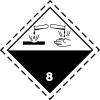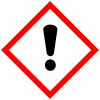HAZMAT Class 1 Explosives

Hazmat Class 1 are explosive materials which are any substance or article, including a device, which is designed to function by explosion or which, by chemical reaction within itself is able to function in a similar manner even if not designed to function by explosion.[a]
Class 1 consists of six 'divisions', that describes the potential hazard posed by the explosive. The division number is the second number after the decimal point on a placard.[b] The classification has an additional layer, of categorization, known as 'compatibility groups', which breaks explosives in the same division into one of 13 groups, identified by a letter, which is used to separate incompatible explosives from each other. This letter also appears on the placard, following the number.[c]
The movement of class 1 materials is tightly regulated, especially for divisions 1.1 and 1.2, which represent some of the most dangerous explosives, with the greatest potential for destruction and loss of life. Regulations in the United States require drivers have and follow a pre-prepared route, not park the vehicle within 300 feet (91 m) of bridges, tunnels, a fire, or crowded places.[1] The vehicle must be attended to by its driver at all times while its parked. Drivers are also required to carry the following paperwork and keep it in an accessible and easy to locate location: written emergency instructions, written route plan, a copy of Federal Motor Carrier Safety Regulations, Part 397 - Transport of Hazardous Materials; driving and parking rules. [2] Some tunnels and bridges severely restrict or completely forbid vehicles carrying Class 1 cargoes.[3][4]
Divisions
Placards
| United States Department of Transportation Placards | UN transport placard | Division number | Risk | Examples |
|---|---|---|---|---|
 |
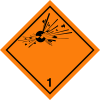 |
(N/A) |
Basic placard for explosive materials - Division not specified |
Anything listed below
|
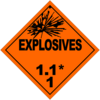 |
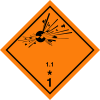 |
1.1 |
Mass explosion risk |
|
 |
 |
1.2 |
Blast and Projection risk |
Hand grenades
|
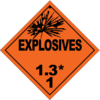 |
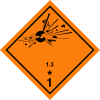 |
1.3 |
Minor blast risk |
Display/commercial grade fireworks, rocket propellant
|
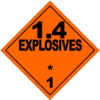 |
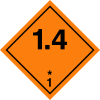 |
1.4 |
Major fire risk |
|
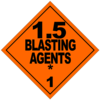 |
 |
1.5 |
Blasting agents |
Type E water emulsion blasting agents
|
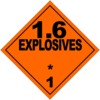 |
 |
1.6 |
Extremely insensitive explosives |
Compatibility table
Transportation segregation table
Template:Transport segregation table for HAZMAT class 1 materials
Compatibility group table
Template:Compatibility Table for HAZMAT Class 1 Materials
See also
Notes
- ^ In the United States, an article that meets this guideline, might be otherwise classed in a different class under a provision of Title 49 of the Code of Federal Regulations.
- ^ Example: A division 1 explosive is shown as "1.1" on the placard.
- ^ Most diagrams of placards, including the ones in this article, represent the compatibility group letter with an asterisk ( * ) as a placeholder.
References
- ^ Pennsylvania Department of Transportation (March 2017). "Commercial Driver's Manual - PUB 223" (PDF). pp. 9:11-9:26. Archived from the original (PDF) on 27 March 2017. Retrieved 20 July 2019.
- ^ United States Department of Transportation (June 6, 2019). "PART 397—TRANSPORTATION OF HAZARDOUS MATERIALS; DRIVING AND PARKING RULES". eCFR. Archived from the original on 10 June 2019. Retrieved 20 July 2019.
- ^ Pennsylvania Turnpike. "Placarded Loads". Archived from the original on 30 March 2019. Retrieved 20 July 2019.
All Table 1 Materials and All Explosives are prohibited.
- ^ Port Authority of New York and New Jersey. "Hazardous Materials - Transportation Regulations at Tunnel and Bridge Facilities -" (PDF). Archived from the original (PDF) on 10 June 2019. Retrieved 20 July 2019.
- ^ Clayton Penistone Group (25 April 2016). "Safety Data Sheet - Railway Fog Signal". Archived from the original (English) on 21 November 2016. Retrieved 16 July 2019.
- ^ Estes Industries (23 October 2014). "Safety Data Sheet - Model Rocket Motor" (PDF). Retrieved 16 July 2019.


